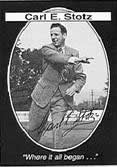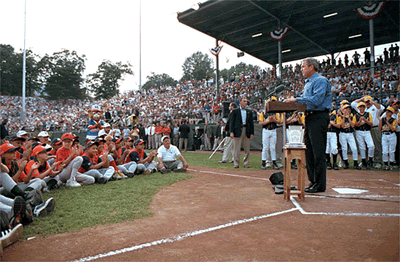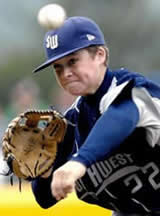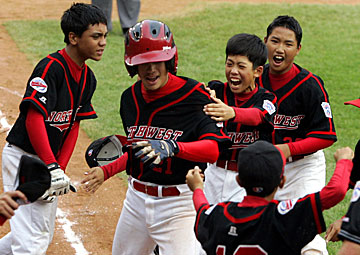
Brian Sipe set passing records at San Diego State University and was named the National Football League’s Most Valuable Player in 1980, when he passed for more than 4,000 yards and led the Cleveland Browns to their first playoff berth in eight years. Yet his greatest sports memory remains playing baseball in a dusty, miniature field in Williamsport, Pennsylvania, when he was 11-year-old Little Leaguer. “Every Little Leaguer dreamed of Williamsport, although none of us really knew where it was or how to get there,” he told the San Diego Union-Tribune in 2001.
How did this remote town of about 30,000 residents become the dream destination of millions of young baseball players? Ever since Little League Baseball was born in Williamsport in 1939, the town and its World Series tournament for 11- and 12-year-old players have formed the epicenter of American youth sports.
The story of Little League can be traced back to a young, ambitious clerk at a local oil-supply company. If Williamsport is the organization’s birthplace, then Carl Stotz is its father.

In the summer of 1938, during which Stotz laid the groundwork for his brainchild, he was 28 years old and working at the Pure Oil Company. He later said the idea of organizing youth baseball came to him in a revelation as he played catch with his two nephews in front of his house on Isabella Street. He let the thought germinate. According to Charles Euchner, a former Little League player and author of Little League, Big Dreams, Stotz then asked his nephews a series of questions:
How would you boys like to play on a baseball team? How would you like to play in uniforms, just like the major-league players use? With real equipment – a fresh supply of balls and bats, with catcher’s gear. Umpires would call the games, so arguments about balls and strikes, catch or no catch, fair or foul, would not interrupt play. Coaches would teach players. Someone would keep score. At the end of the year, the best teams would play for the championship of the league. What do you think of that, boys?
It turned out that the pair liked the idea quite a bit, prompting them to gather their friends for practice the following day. Up to that point, kids could only play organized ball once they reached high school. Although the boys were excited, the real league wouldn’t truly take off until the following spring.
Stotz recruited players at the local schools and churches. He and the recruits cleared a vacant lot, marked out a baseball diamond two-thirds the size of regulation dimensions, built a backstop, and planted grass. The eager Stotz also sought financial support from local businesses, three of which gave in to his pitch and together donated a few hundred dollars. The original three teams, which were managed by Stotz and his two brothers-in-law, bore the names of these sponsors: Lycoming Dairy, Lundy Lumber, and Jumbo Pretzel. On June 6, 1939, Lundy Lumber defeated Lycoming Dairy 28-3 in the inaugural game.
Stotz dubbed the fledgling project “Little League,” and espoused his goals of teaching sportsmanship, fair play, and teamwork to the initial standard of 8- to 12-year-old boys. He started expanding, traveling around central Pennsylvania and then all over the eastern seaboard in order to visit Sunday school classes, school boards, and YMCAs. He told community leaders that boys should be able to play like the big-leaguers they idolized and that these local leagues were the perfect solution.
Although Little League was not the first league to attempt organized youth baseball, it signaled the first such attempt that actually flourished outside of the original community. New leagues started popping up in 1940. In order to provide structure to expansion, the national offices limited each new league to a geographical area encompassing about 20,000 residents. Stotz and the organizers hoped to avoid player disputes and to keep competition fairly even with this approach.
In 1947, the first year of the Little League World Series, Hammonton, New Jersey, founded the first Little League outside of Pennsylvania. By 1951, the organization had grown to 776 separate programs. By 1956, the total skyrocketed to more than 4,000, and another thousand had sprung up in just another three years. Former President Herbert Hoover called the vastly popular union of local leagues “one of the greatest stimulants of constructive joy in the world.”
With more than 8,000 leagues in more than 80 countries, the Williamsport export is now the world’s largest organized sports program. Millions of players and nearly 200,000 teams participate annually, and almost all of them enter summer tournaments in hopes of reaching the World Series held each August in South Williamsport.
In 1947, the Little League board of directors had decided to organize a tournament for all known programs, which at the time amounted to 17. Eleven teams – ten from Pennsylvania and one from New Jersey – accepted the invitation to what was then named the National Little League Tournament.
At first glance, the area appears an unlikely site for both the launching of Little League and its premier tournament. Nestled in a picturesque valley next to the Susquehanna River, it looks more a preserved fragment of an earlier, perhaps simpler, time. In the late 1800s, Williamsport was the lumber capital of the world. Long before the town became known for baseball, the logging industry there spawned the highest concentration of millionaires anywhere in the world. The money brought opulent homes, theaters, hotels, restaurants, and public spaces. Vestiges of that wealth can still be seen on Millionaire’s Row, where imposing Victorian mansions still stand.
However, two floods in the 1890s destroyed the city’s industrial structure. As the lumber industry declined, city leaders were forced to take Williamsport in a new direction. The town retains much of the looks and charms of the high-rolling lumber days, but evidence of hard times also covers the buildings and parks, like dust on an ornate antique. A planning document even calls the city’s history since the floods “a story of unceasing struggle for survival.”
In many ways, the annual World Series for 11- and 12-year-olds has replaced lumber as the symbol of Williamsport and its surrounding boroughs. Since 1947, the excitement and tourism appeal of the tournament has helped revitalize the area. In the inaugural year, the Maynard Midget League of Williamsport took the title, besting the Lock Haven All Stars 16-7 in a game that drew 2,500 spectators. Those are gaudy attendance numbers for a game between teams of prepubescent players. The modern numbers, however, dwarf those from early years and bring thousands to Williamsport each summer. The championship game routinely draws more than 40,000 fans, and the ten-day tournament attracts well over 250,000 people who breathe life into an otherwise quiet area.
Just as the spectacle has grown – and the competition has grown from a regional tournament to a four-team national one, then an eight-team international tournament in the ‘50s and its current incarnation as a 16-team contest – so has its location. The tournament has moved from the original small field in Williamsport proper to a state-of-the-art complex across the river on Route 15. The complex contains two stadiums; Howard J. Lamade Stadium, named after an executive of both Little League and local newspaper Grit, was the original field at this site. Little League Volunteer Stadium was completed in 2001, just in time to accompany the expansion of the tournament to 16 teams.

Another vital part of the baseball complex is the Peter J. McGovern Little League Museum, which is named after the organization’s first full-time president and one of the chief architects of its rise. The museum celebrates the baseball brand’s past and present. A Hall of Excellence enshrines Little League alumni who have gone on to become adult role models. It includes several former Little League World Series players – such as Gary Sheffield, Jason Bay, Lastings Milledge and Jason Varitek – who went on to careers in the major leagues. However, the Hall of Excellence is not limited to only baseball stars. Notable members represent a broad spectrum of sports and other professions, such as entertainment and politics. Cal Ripken, Jr., Nolan Ryan, Mike Ditka, Troy Aikman, Doug Flutie, Pierre Turgeon, Kareem Abdul-Jabbar, Bruce Springsteen, Danny Devito, Kurt Russell, Senator Joe Lieberman and President George W. Bush are all immortalized with plaques in the museum. Faces of Little Leaguers turned generals, doctors, writers and public servants also grace those walls.
In addition to the Hall, the museum features interactive displays, films, and exhibits that bring the players and the evolution of the game to life. Batting and pitching areas even feature instant replay to allow visitors to check their technique. Entrance is $5 for adults, $3 for senior citizens, and $1.50 for children ages 5 to 13 (and free for those younger).
The complex also includes an Olympic-style village for the World Series players and staff, who live and eat for free during their stays. Upon arrival, the budding athletes explore the dorms and adjoining training complex, and slide down the “The Hill,” a grassy bank past the outfield at Lamade Stadium on which some fans relax and watch the games. Later, the players go over game film in their dorms with their coaches. Preparations can be grueling, especially after weeks of play just to get to this point.
The players go through a rigorous schedule of games for the chance to get to Williamsport and its nationally televised matches on ABC and ESPN. (Twenty-seven World Series games and eight regional finals are now televised. They can draw more viewers than some big-league games, with the current record television audience at almost 10 million viewers.) More than 7,000 teams composed of local all-stars begin the march to Williamsport in the Little League Baseball division during the first week of June, and more than 6,500 are eliminated in the first three weeks of pool play. The teams that survive the local district tournaments move on to the state, province or country tournaments. Those winners go to the regional tournaments. Outside the U.S., the regions are Canada, Mexico, the Caribbean, Latin America, Asia, Pacific, a European-Middle Eastern-African region called EMEA, and a Trans-Atlantic region composed primarily of Americans living abroad. The winners of the sixteen regional tournaments move on to represent their states or countries at Williamsport in late August.

All the teams that reach the Little League World Series are undefeated. Some play as many as 20 games in the qualifying tournaments. The World Series features some of the age group’s best players, although some are being drawn to travel baseball teams and competing organizations, such as the Ripken and PONY youth leagues. (Both Ripken and PONY baseball offer field dimensions and equipment closer in size to that of the majors, and the former carries the financial clout and name recognition of Cal Ripken, Jr., baseball’s iron man. While neither yet matches Little League’s participants, both are growing rapidly.) Despite the new competition, Little League still attracts much, albeit not always evenly distributed, talent. Some players tower over their peers, reaching 6-foot-5 and powering the ball deep into the bleachers. Thanks to the fields’ small dimensions, some of the pitchers’ fastballs reach home plate at the equivalent of 90 to 100 miles per hour. A 72-mile-per-hour pitch from a 12-year-old’s arm, for example, gives the batter as much time to react as a 94-mile-per-hour pitch from a professional hurler.
Despite this, Little League chronicler Charles Euchner contends that the appeal of the league and the Williamsport playoffs doesn’t necessarily lie in the quality of the play. Fans enjoy seeing gifted players who are still developing into their full-blown athleticism. The works-in-progress mold themselves further with each game. The potential and mystery make up part of the charm, Euchner notes. He writes, “There’s no telling which of the kids playing in Williamsport might turn out to be a great athlete, worthy of a pro contract, a college scholarship, or even a starting position on a high school team.” The chance of witnessing a young, unpolished Hank Aaron or Barry Bonds adds electricity to the tournament air.
For all the high hopes of the players, as well as the pressure from parents, coaches, and the media, one must remember that the entire event celebrates the game. For many players, the Little League World Series will be the pinnacle of their achievements in the sport. For some of the elite players, it may mark the last moment before the game became a business, an investment. At this stage, everyone still comes in hopes of advancing through the tournament. And if they can’t win the championship, at least they get to play the game they love on bright, manicured grass in front of thousands of people.
After spending two weeks with the teams, coaches, staff, and enthusiasts, Euchner tried to sum up his excitement and concerns. “I was relieved when I saw players from Canada and Guam romp around the Little League complex,” he wrote. “I was impressed to see the Japanese team practice together like dancers – and break into laughter in between routines. I smiled when I heard that the players from Westbrook, Maine, tramped down to the field after their games ended to gather samples of dirt from the infield as souvenirs. These are the things that have a chance of lasting – not just memories, but ways of living – long after the innocent dreams of winning a championship.”

The game may be evolving at a frightening pace. Amid steroid allegations and scandal, Major League teams scrutinize ever-younger players, sending scouts to the far reaches of the globe in search of the next can’t-miss prospect. Kids barely into middle school enter farm systems. Teams hope for the next Roberto Clemente, and the 13-year-old hopes for riches and endorsements. Little League is not untouched by this phenomenon, as demonstrated by the many TV cameras and corporate sponsors at the tournaments. Yet for many players and fans at the Little League World Series, the game may briefly be as pure as possible. For a few weeks, the potential of big money may not matter. Only the big stage matters. Only the baseball matters.
Sources:
- Euchner, Charles. Little League, Big Dreams. Naperville, IL: Sourcebooks, 2006.
- Little League Online. 2007. Little League Baseball. 6 Feb. 2008 <http://www.littleleague.org/>.
